Businesses in the electricity, gas, steam and air conditioning supply sector
Data extracted in February 2024
Planned article update: February 2025
Highlights
The network energy supply sector employed 1.3 million persons in the EU in 2021 and generated €1.9 trillion net turnover.
The highest wage-adjusted labour productivity ratio among all sectors of the EU's business economy was recorded for the network energy supply sector in the EU in 2021.
This article presents an overview of statistics for the European Union's (EU's) electricity, gas, steam and air conditioning supply sector, as covered by NACE Rev. 2 Section D, hereafter referred to as the network energy supply sector. This article belongs to a set of statistical articles on 'Business economy by sector'.
Full article
Structural profile
There were 172 800 enterprises classified within the EU's network energy supply sector (Section D) in 2021, an increase of 4.0 % compared with 2020. These enterprises employed 1.3 million persons in 2021, 2.3 % more than the previous year and generated €256.7 billion of value added, an increase of 9.4 % compared with 2020 and registered 47.3 % more net turnover than in 2020, €1.9 trillion. The EU's network energy supply sector as a whole contributed 0.9 % of all persons employed in the business economy (Sections B to N and P to R, as well as Divisions S95 and S96) in 2021, but accounted for a 2.7 % share of business economy value added — three times as high as its share of employment. These very different shares indicate a very high apparent labour productivity within the network energy supply sector and reflect its capital-intensive nature.
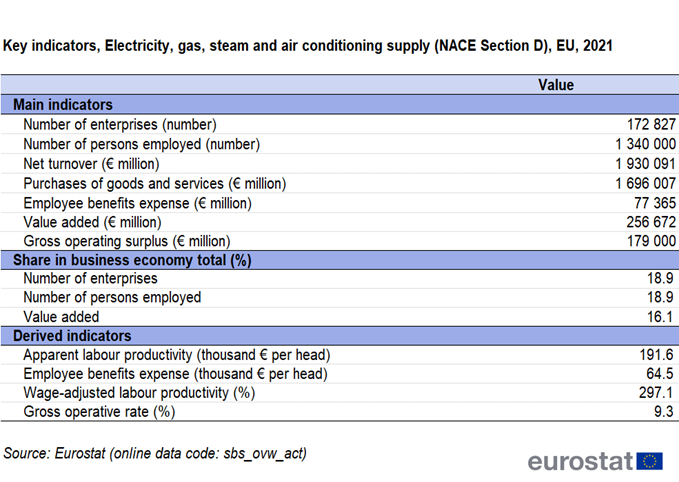
Source: Eurostat (sbs_ovw_act)
Network energy supply sector was the third smallest among the NACE sections within the business economy in 2021 in terms of persons employed, as only the repair of computers and personal and household goods sectors and the mining and quarrying employed fewer persons. However, network energy supply recorded the second highest level of apparent labour productivity among the NACE sections that compose the business economy, after the financial and insurance activities, averaging €191.6 thousand per person employed in 2021, well above the business economy average of €60.2 thousand per person employed.
The average employee benefits expense (average personnel costs) for the network energy supply sector was €64.5 thousand per employee (again the second highest level among NACE sections within the business economy, after the financial and insurance activities), and €25.5 thousand per employee higher than the average for the whole of the business economy (€39.0 thousand per employee). The wage-adjusted labour productivity ratio combines the two previous indicators and shows the extent to which value added per person employed covers average personnel costs per employee. Due to the exceptionally high productivity and somewhat less elevated average personnel costs, the EU's network energy supply sector recorded the highest wage-adjusted labour productivity ratio among NACE sections within the business economy in 2021: 297.1 % compared with the business economy average of 154.4 %.
Sectoral analysis
The electric power generation, transmission and distribution subsector (Group 35.1, hereafter referred to as the electricity supply subsector) was by far the largest part of the network energy sector, contributing 84.5 % of sectoral value added in 2021. Manufacture of gas; distribution of gaseous fuels through mains subsector (Group 35.2) and steam and air conditioning supply (Group 35.3) had similar shares in terms of number of enterprises and persons employed, but in terms of value added manufacture of gas; distribution of gaseous fuels through mains had a higher share (10.5 %) than steam and air conditioning supply (4.8 %).
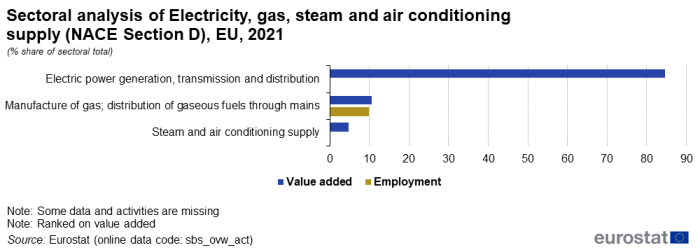
(% share of sectoral total)
Source: Eurostat (sbs_ovw_act)
Among the three subsectors that form the network energy supply sector, electricity supply subsector dominates in almost all indicators for which data is available; number of enterprises (93.2 %), employee benefits expense (81.5 %) and turnover (82.9 %).

Source: Eurostat (sbs_ovw_act)
Country overview
Figure 2 shows that the share of network energy supply sector within the business economy's value added in 2021 was in the range of 0.9 % in Malta and Luxembourg to 5.3 % in Poland, while the EU average was at 2.7 %. The share in employment terms was much lower, ranging from 0.3 % in Spain to 1.5 % in Bulgaria.
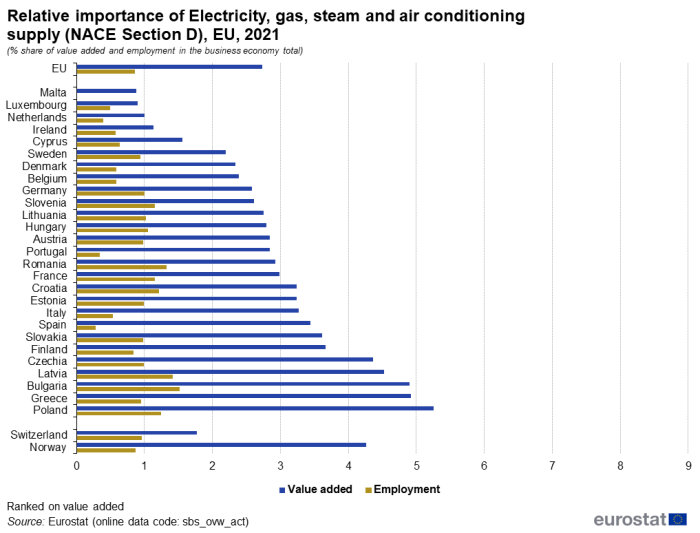
(% share of value added and employment in the business economy total)
Source: Eurostat (sbs_ovw_act)
The network energy supply sector appears to be concentrated, in terms of the contribution made by the five largest EU Member States towards its value added, quite in line with the business economy average. In value added terms the contribution in 2021 was highest in Germany, where it accounted for 29.3 %, followed by France (14.5 %), Italy (10.5 %), the Netherlands (8.7 %) and Spain (7.2 %). Therefore, the contribution of the top five countries in the network energy supply sector is 69.7 % which is in line with the contribution of the top five countries for the total business economy (70.1 %).
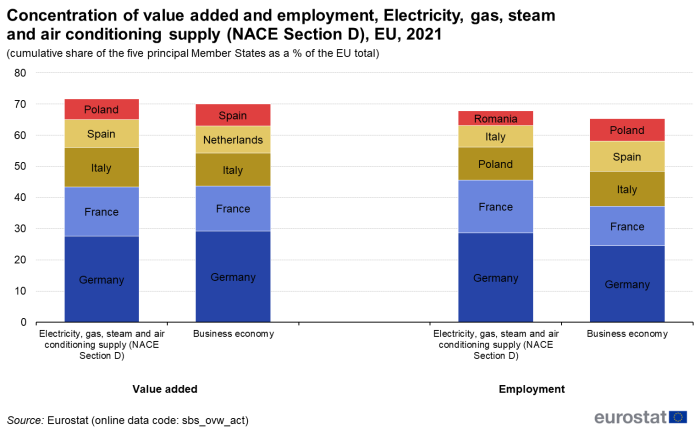
(cumulative share of the five principal Member States as a % of the EU total)
Source: Eurostat (sbs_ovw_act)
In value added terms, Germany had the largest contribution of all EU Member State in 2021; mainly as a result of the electricity supply subsector which accounted for 25.0 % share of EU value added. Italy recorded the highest share of value added in manufacture of gas; distribution of gaseous fuels through mains (hereafter referred to as the gas supply subsector) with 3.1 % share of EU value added. Bulgaria's specialisation rate for the electric power generation, transmission and distribution was high and amounted to 4.9 % of the business economy value added, while for the whole network electricity supply sector, Poland had the highest specialisation, 5.3 %.

Source: Eurostat (sbs_ovw_act)
In absolute terms, Germany, France and Poland had the largest number of persons employed in the network energy supply sector in 2021, while the highest net turnover was recorded in Germany (€826.9 billion), far ahead of Italy (€272.2 billion), France (€159.0 billion) and Spain (€118.0 billion).
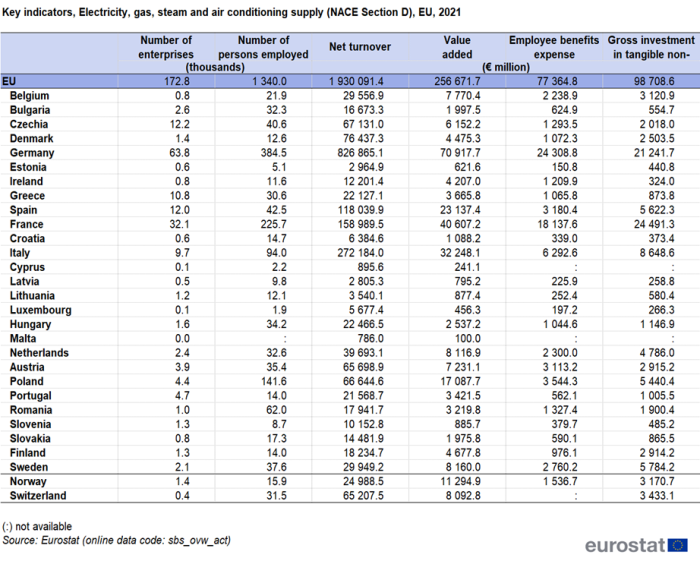
Source: Eurostat (sbs_ovw_act)
Among the EU Member States, the highest apparent labour productivity in the network electricity supply sector in 2021 was recorded in Spain, where this measure reached €545 000 per person employed. This was quite ahead of the next highest level of apparent labour productivity, namely €362 000 per person employed recorded in Ireland and €354 800 in Belgium. In Norway and Switzerland the apparent labour productivity in distributive trade was above the EU average, with Norway recording €712 100. High average employee benefits expenses, over €100 000 per person employed were recorded in Belgium, Luxembourg, Ireland and Austria.
Combining these two indicators gives the wage-adjusted labour productivity ratio, which is a measure of labour productivity that takes into account the very different levels of pay and social charges between Member States and activities. The wage-adjusted labour productivity ratios were in 2021 quite high in most Member States, ranging from 203.4 % in Austria to 659.4 % in Spain.
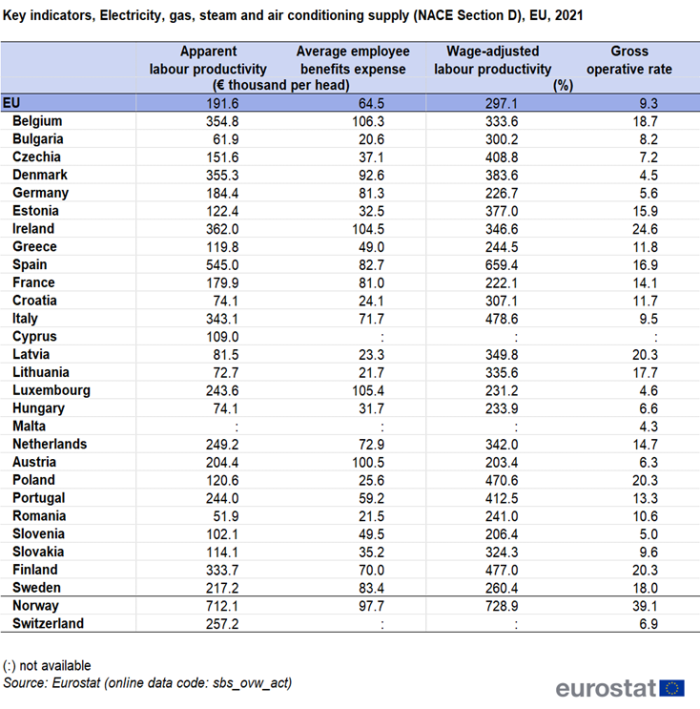
Source: Eurostat (sbs_ovw_act)
Data sources
Coverage
The electricity, gas, steam and air conditioning supply sector, NACE Rev. 2 Section D, referred to in this article as the network energy supply sector, concerns the provision of electric power, natural gas, steam, hot water and the like through a network (permanent infrastructure) of lines, mains and pipes. Apart from transmission and distribution through a network, this activity also includes the generation of electric power and the production of steam, hot or chilled water and cooled air.
The network energy supply sector comprises three NACE groups, as follows:
- the production, transmission, distribution and trade of electricity (Group 35.1), which can be generated from fossil, nuclear or renewable fuels;
- the manufacture, distribution and trade of gas via mains (Group 35.2), excluding the (typically long-distance) transport of gas through pipelines, the bulk sale and transport of gaseous fuels or its distribution in canisters, and also the manufacture of refined petroleum products and industrial gases;
- the supply of steam and air conditioning (Group 35.3), including the production, collection and distribution of steam and hot water (for example, for heating and power), cooled air, chilled water for cooling and ice; this network distribution of steam and hot water may be for the purpose of city heating, also known as district heating.
Data sources
The analysis presented in this article is based on the main dataset for structural business statistics (SBS), size class data and regional data, all of which are published annually.
The main series provides information for each EU Member State as well as a number of non-member countries at a detailed level according to the activity classification NACE. Data are available for a wide range of variables. Structural business statistics cover the 'business economy', which includes industry, construction and many services (NACE Rev. 2 sections B to N, P to R as well as division S95 and S96). Structural business statistics do not cover agriculture, forestry and fishing, nor public administration. Structural business statistics describe the business economy through the observation of units engaged in an economic activity; the unit in structural business statistics is generally the enterprise. An enterprise carries out one or more activities, at one or more locations, and it may comprise one or more legal units. Enterprises that are active in more than one economic activity (plus the value added and turnover they generate, the people they employ, and so on) are classified under the NACE heading corresponding to their principal activity; this is normally the one which generates the largest amount of value added.
In structural business statistics, size classes are generally defined by the number of persons employed. A limited set of the standard structural business statistics variables (for example, the number of enterprises, turnover, persons employed and value added) are analyzed by size class, mostly down to the three-digit (group) level of NACE. The main size classes used in this article for presenting the results are:
- small and medium-sized enterprises (SMEs): with 1 to 249 persons employed, further divided into:
- micro enterprises: with less than 10 persons employed;
- small enterprises: with 10 to 49 persons employed;
- medium-sized enterprises: with 50 to 249 persons employed;
- large enterprises: with 250 or more persons employed.
Structural business statistics also include regional data. Regional SBS data are available at NUTS levels 1 and 2 for the EU Member States, Iceland and Norway, mostly down to the two-digit (division) level of NACE. The main variable analyzed in this article is the number of persons employed. The type of statistical unit used for regional SBS data is normally the local unit, which is an enterprise or part of an enterprise situated in a geographically identified place. Local units are classified into sectors (by NACE) normally according to their own main activity, but in some EU Member States the activity code is assigned on the basis of the principal activity of the enterprise to which the local unit belongs. The main SBS data series are presented at national level only, and for this national data the statistical unit is the enterprise. It is possible for the principal activity of a local unit to differ from that of the enterprise to which it belongs. Hence, national SBS data from the main series are not necessarily directly comparable with national aggregates compiled from regional SBS.
Context
The EU's gas and electricity internal markets have been changing through the requirements of the second and third electricity and gas directives adopted in 2003 and July 2009. The aim of opening-up European energy markets to competition has been to provide households and business with greater choice, lower prices, better service and improved security of supply. By 3 March 2011, these gas and electricity directives had to be transposed into national law by Member States and three Regulations (one on conditions for access to the natural gas transmission networks, one on conditions for access to the network for cross-border exchanges in electricity, and one on the establishment of an agency for the cooperation of energy regulators) became applicable on that date.
Policies related to energy and to climate change are particularly important for many parts of the network energy supply sector. The EU aims to become a low-carbon, energy-efficient economy in the coming decades. The integrated energy and climate change policy laid out in December 2008 aimed to cut greenhouse gases by 20 %, reduce energy consumption by 20 % through increased energy efficiency and to meet 20 % of the EU's energy needs from renewable sources by 2021 — these goals had implications on the way network energy suppliers operate.
In March 2010, the Europe 2021 strategy was adopted: this is the EU's strategy for smart, sustainable and inclusive growth. It is a strategy to enhance the competitiveness of the EU and to create more growth and jobs. A resource-efficient Europe is one of the flagship initiatives of this strategy that aims to support the shift towards a resource-efficient, low-carbon economy to achieve sustainable growth. Within this broad initiative are several energy related initiatives. The Energy 2021 strategy for competitive, sustainable and secure energy was adopted in November 2010 by the European Commission. It defined energy priorities through until 2021 and set out actions to be taken in order to tackle the challenges of saving energy, achieve a market with competitive prices and secure supplies, boost technological leadership, and effectively negotiate with international partners. Energy infrastructure priorities for 2021 and beyond were adopted at the same time and are intended to serve as a blueprint for an integrated European energy network, which defines EU priority corridors for the transport of electricity, gas and oil. In March 2011 the European Commission adopted the Energy efficiency plan 2011: energy efficiency is seen as one of the most cost-effective ways to enhance security of energy supply and to reduce emissions of greenhouse gases and other pollutants. In April 2011, the European Commission adopted the Communication Smart grids: from innovation to deployment which sets out policy directions to stimulate the deployment of electricity networks making use of progress in information and communication technologies to make electricity distribution more efficient and so reduce costs and emissions.
With its Roadmap for moving to a competitive low-carbon economy in 2050, the European Commission has looked beyond short-term objectives and set out a cost-effective pathway for achieving much deeper emission cuts by the middle of the 21st century. The EU is committed to reducing greenhouse gas emissions to a level 80–95 % below 1990 levels by 2050, given that there are also necessary reductions by other developed economies. In an Energy Roadmap 2050 (COM(2011) 885 final) the European Commission explored the possible challenges that may be faced in order to meet the EU's decarbonisation objective, while at the same time ensuring security of energy supply and competitiveness.
Direct access to
- Recent Eurostat publications on SBS
- Key figures on Europe – 2023 edition – see subchapter on Business
- Eurostat's Regional Yearbook – see chapter 8. Business
- News Release SBS – 2021 final data
Glossary
ESMS metadata files
- Structural business statistics – SBS metadata file